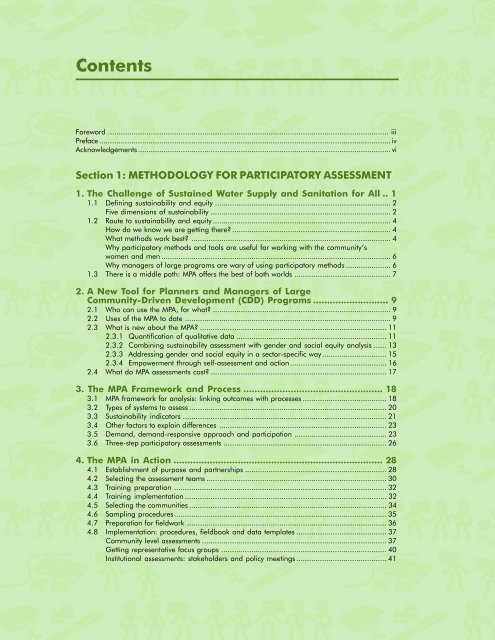Sustainability Planning and Monitoring
Sustainability Planning and Monitoring
Sustainability Planning and Monitoring
- No tags were found...
Create successful ePaper yourself
Turn your PDF publications into a flip-book with our unique Google optimized e-Paper software.
ContentsForeword ................................................................................................................................... iiiPreface ........................................................................................................................................ ivAcknowledgements...................................................................................................................... viSection 1: METHODOLOGY FOR PARTICIPATORY ASSESSMENT1. The Challenge of Sustained Water Supply <strong>and</strong> Sanitation for All .. 11.1 Defining sustainability <strong>and</strong> equity .................................................................................. 2Five dimensions of sustainability .................................................................................... 21.2 Route to sustainability <strong>and</strong> equity ................................................................................... 4How do we know we are getting there? .......................................................................... 4What methods work best? ............................................................................................. 4Why participatory methods <strong>and</strong> tools are useful for working with the community’swomen <strong>and</strong> men ........................................................................................................... 6Why managers of large programs are wary of using participatory methods ..................... 61.3 There is a middle path: MPA offers the best of both worlds ............................................. 72. A New Tool for Planners <strong>and</strong> Managers of LargeCommunity-Driven Development (CDD) Programs ........................... 92.1 Who can use the MPA, for what? ................................................................................... 92.2 Uses of the MPA to date ................................................................................................ 92.3 What is new about the MPA? ....................................................................................... 112.3.1 Quantification of qualitative data ...................................................................... 112.3.2 Combining sustainability assessment with gender <strong>and</strong> social equity analysis ...... 132.3.3 Addressing gender <strong>and</strong> social equity in a sector-specific way.............................. 152.3.4 Empowerment through self-assessment <strong>and</strong> action............................................. 162.4 What do MPA assessments cost? .................................................................................. 173. The MPA Framework <strong>and</strong> Process .................................................. 183.1 MPA framework for analysis: linking outcomes with processes ....................................... 183.2 Types of systems to assess ............................................................................................ 203.3 <strong>Sustainability</strong> indicators ............................................................................................... 213.4 Other factors to explain differences .............................................................................. 233.5 Dem<strong>and</strong>, dem<strong>and</strong>-responsive approach <strong>and</strong> participation ........................................... 233.6 Three-step participatory assessments ............................................................................ 264. The MPA in Action ........................................................................... 284.1 Establishment of purpose <strong>and</strong> partnerships .................................................................. 284.2 Selecting the assessment teams .................................................................................... 304.3 Training preparation ................................................................................................... 324.4 Training implementation .............................................................................................. 324.5 Selecting the communities ............................................................................................ 344.6 Sampling procedures................................................................................................... 354.7 Preparation for fieldwork ............................................................................................. 364.8 Implementation: procedures, fieldbook <strong>and</strong> data templates .......................................... 37Community level assessments ...................................................................................... 37Getting representative focus groups ............................................................................. 40Institutional assessments: stakeholders <strong>and</strong> policy meetings .......................................... 41
















